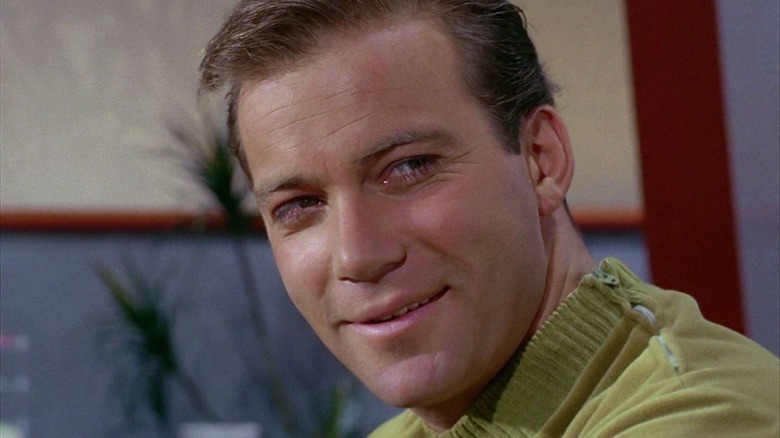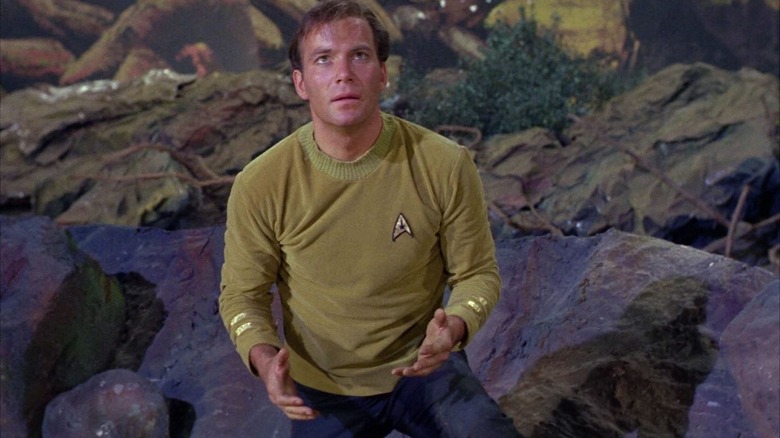Star Trek's William Shatner Says There's Only One Way He'd Allow An AI-Generated Kirk
There's a current Hollywood trend that is wholly disturbing. Many major studios — but primarily Disney — have been spending millions of dollars and hiring hundreds of effects technicians, animators, and designers to digitally resurrect dead actors to include in their franchise movies. The film "Alien: Romulus" did this recently, while the movies "Rogue One: A Star Wars Story" and "Ghostbusters: Afterlife" hired actors Guy Henry and Bob Gunton to portray characters previously played by the late Peter Cushing and Harold Ramis before digitally altering them to resemble their predecessors. While Cushing's estate and Ramis' family signed off on this, it's still different from a living actor giving their consent to be digitally altered, like Jeff Bridges did for "TRON: Legacy."
The first example of digital grave robbing likely came in 2004 with the release of Kerry Conran's "Sky Captain and the World of Tomorrow," which featured a digital performance by the late Laurence Olivier (who died in 1989). It is, of course, a strange, ghoulish act to digitally recreate a dead actor merely so their likeness can push nostalgia buttons in an over-moneyed blockbuster, but studios seem to be increasingly shameless about it. They've been so shameless, in fact, the SAG/AFTRA is taking legal action to prevent studios from exploiting actors by using "invisible" AI and CGI to co-opt their performances.
William Shatner, however, has a little bit more of a pragmatic view. Knowing the current shape of the pop landscape, Shatner is aware Paramount may very well use his youthful likeness of Captain Kirk in a time-travel-themed "Star Trek" project in the near future. In an interview with ComicBook.com in January 2024, the 93-year-old actor said that he would be content to play Kirk himself, but after his death, he knows recreating his likeness may be a great way to earn posthumous money for his family.
Shatner wants his family to be paid
Mind you, when it comes to digitally recreating a young William Shatner for "Star Trek," that seal may've already been more than healthily broken. When J.J. Abrams rebooted "Star Trek" with his high-octane 2009 feature film of the same name, he merely recast Kirk with actor Chris Pine. Then, when the creatives behind the TV series "Star Trek: Strange New Worlds" wanted to include Kirk in its stories, they hired actor Paul Wesley to play the part. Neither the film nor the show, as far as I know, tried to digitally recreate a young Shatner for the role.
Still, seeing as how nostalgia-driven the industry has been for the last 15 years or so, Shatner understands that there may very well be a future "Star Trek" project that would bother to make a digital mannequin of him. Shatner didn't like the idea of a studio developing a fake, AI version of him, as he's still alive and willing to play the part himself. After his death, though, he has a different outlook. In his own words:
"It's an interesting question. [...] The strike was all about getting permission to do that. And so if I'm alive, I don't want AI to do that, but if I'm dead, and they ask my family, and they're going to pay my family very well to sound like me, I would advise them to say yes."
Shatner, it seems, isn't interested in a legacy. He likes working and would happily be paid for his performances, but he's ready to let digital artists take over once he passes. Because he is 93, Shatner — who is sprier than most folk in their 90s — often jokes about being at death's door; at a recent "Star Trek" convention, a fan asked what was next in his career, and he lightheartedly replied, "To die!"
Many actors would prefer their likenesses never be used without their strict participation, and the actors' strike proved it. But if an actor consents before their deaths, and their estate gets to reap the financial benefits, then perhaps studios can dig up corpses to their hearts' content.

